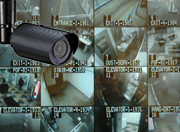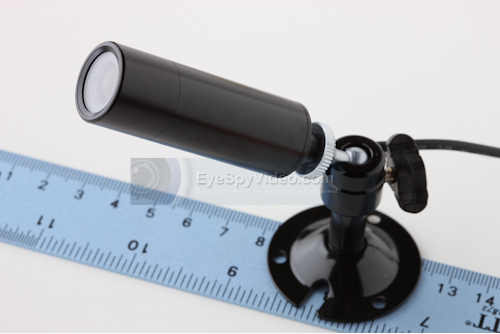Analog Vrs Digital
Please click here to see our DVR FAQ Answer Page for additional information
1. What is the difference between digital and analog video / audio recording?
2. What are advantages and disadvantages of each?
3. What is the difference between realtime and time lapse recording?
5. What is "video motion detection" and its pros and cons?
6. What's the difference between your DVR units and a Tivo type digital recorder?
Q1: What is the difference between digital and analog recording?
A1: For all practical purposes, analog recording is what we generally think of when using our vcr or audio cassette recorders. Analog recording consists of heads writing or reading signals directly onto a medium (like a tape) with a magnetic encoding. Digital, on the other hand - also reads/writes data but encodes the signals into a numeric string of digits. There are a couple different ways in which we generally use digital video/ audio recording:
1. Directly onto a computer's magnetic hard drive through a variety of compression formats- such as in PC (Windows) based systems and embedded OS / Linux based systems such as our DVR-RT4X, or;
2. Onto a magnetic tape cassette, as used with mini decks (Sony's GVD-200 and GVD-800) and new digital camcorders. The major tape formats found in new digital camcorders are Sony's 'Digital 8' or the more common 'Mini-DV' . No analog equipment will record or playback digital media, but some digital units (GVD-200/ 800) do have the ability to playback analog format(s). 8mm, Hi-8 and VHS-C are the standard tape formats for today's analog camcorders.
*Mini decks and camcorders are used in limited covert and mobile uses for short-term recording, but are generally not considered part of the security / surveillance industry. Please click here to see a terrific miniature digital video recorder made for portable use.
Digital technology has become much more stable and reliable in the last 2 or 3 years and is quickly replacing analog video recording to the point of impending extinction. If you didn't rush into anything- and are still clinging to your worn out old timelapse VCR- there's no better time than NOW to upgrade it. Prices have finally become AFFORDABLE for a product which is actually both reliable AND user friendly.
One KEY advantage to DIGITAL is its higher resolution ability. Depending on features of individual unit, you may be able to achieve 480+ horizontal lines recording with digital recorders vs. 300 lines color (350 bw) with the highest quality analog units (such as our high band/ high density Sanyo models). Most analog recorders permit only about 280 lines for black and white and 240 lines for color.
Analog recording can still be argued to be little reliable due to the fact that a videotape (mechanical) drive system is not likely to "crash" like a computer hard drive or operating system might, risking some or all data to irretrievable loss. And many security professionals are using redundancy systems with a digital recorder as the primary system- backed up by a high density/ high resolution analog VCR.
Back to top-->
Q2: What are advantages and disadvantages of each?
A2: Digital is certainly the way ALL video recording will be done in the future (and likely the very near future). However, it does still have some drawbacks to consider. Many systems have low frame speed ability per camera when recording multiple cameras at once. Analog recording is still generally considered a little more reliable due to the fact that a videotape (mechanical) drive system is not likely to "crash" like a computer hard drive or operating system might, risking some or all data to irretrievable loss. Most PROFESSIONAL security people will employ BOTH nowadays- generally a digital recorder connected to a (high bandwidth/ high resolution) VCR as a redundant 'backup' system.
DVRs must really be separated into 2 main categories: PC-based and Linux-based operating systems (OS). Think about it... how many times has your PC 'crashed' due to a glitch or flaw in Windows systems or programs?! Don't you want potentially life-saving evidence to be recorded into a stable and re-accessible format? We waited, watched and learned while a lot of our competition jumped right into advertising their own PC based systems. Most quickly found that they. *Even though we are highly impressed with the new Linux systems, there are great strides being currently made to bypass an operating system altogether by compressing the video through on-board hardware logic rather than any kind of software. Stay tuned but please don't let this hold you back from upgrading right now to a stable Linux-based embedded OS system.
One KEY advantage to DIGITAL is its higher resolution ability. Depending on features of individual unit, you may be able to achieve 480+ horizontal lines of color recording with digital vs. 300 lines color (350 black & white) with the highest quality analog units (such as our high band/ high density models). *Little known fact- most analog VCR video recorders permit only about 280 lines BW and 240 lines of color recording- no kidding! Even for expensive consumer and security '4-head' systems. Why are there separate resolution abilities for color and black & white? Because color requires more bandwidth as it is encoding and decoding more data at one time. Audio (especially mono) requires very little bandwidth at all in comparison to video, even BW/ monochrome.
Please SEE our newest 4 camera digital recorder (#DVR-RT-4X) for a really DYNAMITE unit! It has all the features of several separate and advanced units all in one.
Back to top-->
Q3: What is the difference between 'realtime' and time lapse recording?
A3: Time lapse vcrs use specially engineered recording heads which slow down the video tape to allow intervals of media to be recorded over a longer period of time (generally seen as 960 hours, or 40 days. Unlike realtime VCRs (read below), which feature a smooth flow to the video action, timelapse units essentially take a snapshot of what video camera(s) sees every few seconds. For this reason, it appears jittery and often captures very little video data during the time you may need it most! Think of bank robbery footage you may have seen on television- you oftentimes see suspect(s) cover 20 feet or more in 3 or 4 consecutive frames. Due to the advent of reliable realtime analog and better digital recording, the obvious drawbacks of timelapse recording are quickly making the technology obsolete in today's marketplace- and only recommended for limited or specialized applications. We only offer one time lapse vcr (VCR-5), which features selectable speeds including 24-40 hours of real time recording- which can be extended to over 1000 hours in the slowest time lapse mode.
Realtime VCRs also use specially engineered recording heads which slow down the video tape to allow more media to be recorded onto the tape. Unlike time lapse vcrs which essentially take snapshots every few seconds- appearing jittery and capturing very little video data- real time units feature a smooth flow to the video. Note: ALL real time analog video recorder decks (VCR) require 8 hour T-160 tapes, ratherthan the more common T-120 to achieve advertised recording times. T-160 VHS video tapes are now widely available for under $5 each. However, we even carry the hard-to-find T-200 (10 hour) tapes as well- though they are a little pricier.
Important to note that digital recording DVR systems can also be classified as realtime or timelapse as well- with a couple of minor variables. Rather than physically slowing down the tape heads- it records similar snapshots from each camera onto the hard drive. Many DVR systems offer the ability to manipulate frame speed.
Back to top-->
A4: Alarm recording is considered as any video recording which is prompted by a signal. Generally speaking, alarm recording is achieved when an alarm signal from a dedicated switch (such as a passive infrared, or "PIR" motion sensor) after the device is triggered. Alarm VCRs and DVRs with alarm IN ports are capable of being programmed to record ONLY after such a signal has been received. It should also be noted that video motion detection (built into the software of the recorder or processor rather than) could also be considered an alarm signal. Back to top-->
Q5: What is "video motion detection" and its pros and cons?
A5: Video motion detection is a relatively new technology which attempts to replace external motion sensors and physical switches to achieve 'alarm' (or action-only) recording. It is generally found in three versions- those which use tiny sensor "markers" which you place on the screen. These little dots create an internal alarm in the device when the video underneath them changes (figured as motion). The other kind uses a basic light adjustment feature. The main reported problems with the marker type are that- by the time a subject passes the area in which marker has been installed, more than half of the desired video will never have been recorded. The somwhat newer light sensitive type has been reported to create a lot of false alarms in light changing environments- such as slight movements in the sun or clouds when conducting outdoor surveillance!
The third is the newest and, by far- the MOST desirable. Found in all Eyespyvideo.com DVR units, the technology is called digital pixelation motion detect circuitry (or PMD for short). Finally, a more reliable way has arrived to activate motion recording. However, it must be said that there are a range of quality factors within this technology as well. The ability to mask (or to bypass the function in certain areas onscreen such as for passing cars) and. Furthermore, our DVR systems also have easy to use inputs for external alarm devices in case you want to use physical sensors such as PIRs, bypassing the video motion detection option. They also feature ethernet ports and are TCP/IP addressable so you can connect them to a network and even view over the internet.
Back to top-->
Q6: What's the difference between your DVR units and a Tivo type digital video recorder?
A6: Actually, very little! Tivo-type systems also encode/ decode and store video data. The main difference is that Tivo is designed for primarily single channel recreational/ entertainment recording of programs- not for security applications. So it's not really appropriate for multiple camera uses- especially where most want video motion detection and time/ date stamping, etc.. Back to top-->


 Cart is empty
Cart is empty
 Help
Help

